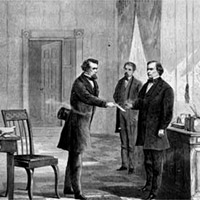 |

喬治‧布朗 (George
T. Brown) 擔任詹森總統在1868年出庭時的法院警衛

|
 |
|
 |
投票彈劾安德魯‧詹森 (Andrew
Johnson) :1868年5月16日
詹森在林肯總統遇刺之後繼任美國總統,他的主要任務就是完成林肯統一這個分裂國家的計畫。1861年到1865年的內戰那時才剛結束不久。詹森計畫通過憲法修正案,完全廢除奴隸制度,讓南方聯盟各州能夠重新推派代表進入國會,並且擁有獨立的治理權。然而,詹森卻沒有林肯卓越的判斷能力。南方各州趁著眾議院休會時,逕行通過「黑人條款」 (Black
Codes) ,限制了自由奴隸所應享有的權益。眾議院因此感到震怒,並且提案制止施行這些條款,但是詹森總統卻否決了眾議院的提案。於是眾議院在1867年3月2日通過美國歷史上第一次推翻否決案,以確保國會有關公民權立法的權利。此外,眾議院還採取了其他的行動。
After becoming president following the assassination of Abraham Lincoln, Johnson wanted to complete Lincoln's plan to reunite the country swiftly. The Civil War (1861-1865) had just ended. His plan was to promote passage of an amendment outlawing slavery, then allow the Confederate states to once again send representatives to Congress and govern themselves. Johnson, however, lacked Lincoln's good judgment. While Congress was in recess, the newly powerful Southern states passed "Black Codes," limiting the rights of freed slaves. An angry Congress proposed a law that would repress those codes; Johnson vetoed it. Congress in return, on March 2, 1867, passed the first override in U.S. history, to protect its civil rights legislation. And on it went.

 2/3 頁
2/3 頁

|





